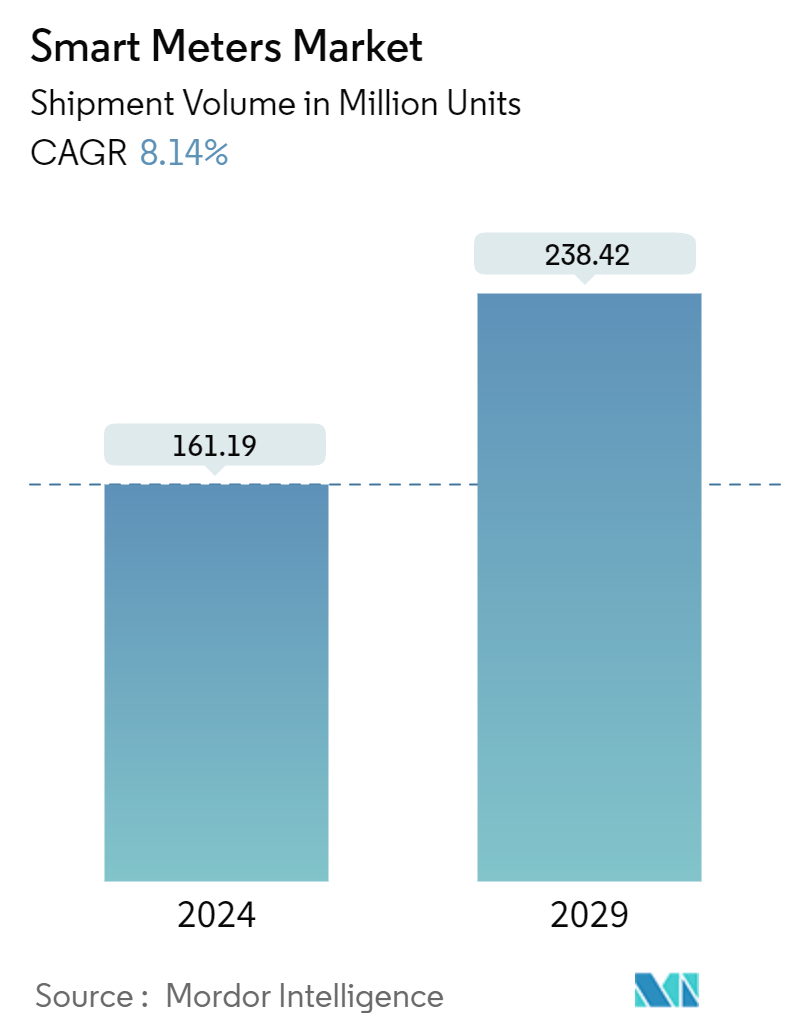Market Size of Smart Meters Industry

| Study Period | 2019 - 2029 |
| Market Volume (2024) | 161.19 Million units |
| Market Volume (2029) | 238.42 Million units |
| CAGR (2024 - 2029) | 8.14 % |
| Fastest Growing Market | Asia Pacific |
| Largest Market | Asia Pacific |
| Market Concentration | Low |
Major Players
*Disclaimer: Major Players sorted in no particular order |
Smart Meters Market Analysis
The Smart Meters Market size in terms of shipment volume is expected to grow from 161.19 Million units in 2024 to 238.42 Million units by 2029, at a CAGR of 8.14% during the forecast period (2024-2029).
- Globally, utilities such as electricity, gas, and water are increasingly adopting smart meters. These meters enable real-time tracking of utility usage for both suppliers and consumers through their two-way communication feature. This functionality not only allows suppliers to remotely start, read, and cut off supply but also aids in implementing home energy management systems (HEMS) and building energy management systems (BEMS). Such systems offer a transparent view of electric power consumption, catering to both individual homes and entire buildings. As smart meters become more prevalent, they are set to enhance energy management and efficiency, aligning with the sustainability goals of various regions.
- As economic activities surge, leading to increased energy consumption, energy efficiency has taken center stage as a global priority. In light of this, regions worldwide are rapidly integrating energy-efficient solutions, like smart meters, across diverse industries to optimize energy and utility usage. This momentum is likely to persist, with governments and organizations increasingly valuing sustainable energy practices. Smart meters are poised to be instrumental in these endeavors, promoting more efficient energy distribution and consumption.
- Financial incentives for grid digitalization, coupled with supportive government policies, are fueling growth in the smart metering market. These elements are set to broaden the market for smart meters in the years ahead, laying a solid groundwork for future innovations and advancements in the sector.
- However, the smart metering market faces challenges, particularly concerning the costs associated with switching utility suppliers. Given that these systems depend on digital components and connectivity, they risk becoming obsolete with technological shifts, which can restrict their adaptability across various suppliers. Furthermore, the unique user interfaces of each utility provider complicate the interchangeability of smart meters, a challenge intensified by the lack of standardized interface developments.
- Additionally, the ongoing global economic downturn has dampened the demand for electronic devices, leading to a reduced appetite for smart meters, which could hinder market growth.
Smart Meters Industry Segmentation
Smart meters, a groundbreaking innovation in the utility industry, facilitate enhanced communication between consumers and suppliers. These advanced devices not only showcase real-time energy consumption but also offer deeper insights into energy patterns. Leveraging a secure smart data network, smart meters automatically transmit readings to energy suppliers, ensuring precise billing.
The smart meters market is segmented by smart gas meters (North America (United States, Canada & Central America), Europe (United Kingdom, France, Italy, and the Rest of Europe), Asia Pacific (China, Japan, and the Rest of Asia Pacific), Rest of the World), by smart water meters (North America (United States, Canada & Central America), Europe (United Kingdom, France, Italy, and the Rest of Europe), Asia Pacific (China, Japan, and the Rest of Asia Pacific), Rest of the World), by smart electricity meters (North America (United States, Canada & Central America), Europe (United Kingdom, France, Italy, and the Rest of Europe), Asia Pacific (China, Japan, and the Rest of Asia Pacific), Rest of the World). The market sizes and forecasts are provided in terms of volume (shipment units) for all the segments.
| By Geography - Smart Gas Meter*** | |||||
| |||||
| |||||
| |||||
| Australia and New Zealand | |||||
| Latin America | |||||
| Middle East and Africa |
| By Geography - Smart Water Meter*** | |||||
| |||||
| |||||
| |||||
| Australia and New Zealand | |||||
| Latin America | |||||
| Middle East and Africa |
| By Geography - Smart Electricity Meter*** | |||||
| |||||
| |||||
| |||||
| Australia and New Zealand | |||||
| Latin America | |||||
| Middle East and Africa |
Smart Meters Market Size Summary
The smart meters market is poised for significant growth, driven by the global shift towards smart grids and the increasing emphasis on energy efficiency and emission control. Smart meters, with their two-way communication capabilities, are being widely adopted for electricity, gas, and water management, allowing real-time tracking of utility usage. This technology is integral to the implementation of Home Energy Management Systems (HEMS) and Building Energy Management Systems (BEMS), which help visualize and optimize energy consumption. The push for digitization and modernization of energy systems, coupled with government support and investments, is further propelling the deployment of smart meters. Countries like India are making substantial strides in this direction, with initiatives to install millions of smart meters as part of national programs.
In the Asia-Pacific region, China leads the market with extensive government mandates, although its rapid deployment phase is nearing completion. Japan is also making significant investments in smart grid technology to reduce carbon emissions, with plans to install millions of smart meters nationwide. The competitive landscape of the smart meter market is characterized by the presence of major players and increasing investments, which are raising barriers to entry and intensifying competition. Strategic acquisitions and partnerships, such as those by Badger Meter Inc. and Diehl Metering Inc., are enhancing the capabilities and reach of smart meter solutions. As urbanization and smart home technologies expand, the demand for smart meters is expected to rise, fostering further growth in the residential segment globally.
Smart Meters Market Size - Table of Contents
-
1. MARKET INSIGHTS
-
1.1 Market Overview
-
1.2 Industry Attractiveness - Porter's Five Forces Analysis
-
1.2.1 Bargaining Power of Suppliers
-
1.2.2 Bargaining Power of Buyers
-
1.2.3 Threat of New Entrants
-
1.2.4 Threat of Substitute Products
-
1.2.5 Degree of Competition
-
-
1.3 Industry Value Chain Analysis
-
1.4 mpact of Macroeconomic Factors on the Global Smart Meter Market
-
-
2. MARKET SEGMENTATION
-
2.1 By Geography - Smart Gas Meter***
-
2.1.1 North America
-
2.1.1.1 United States
-
2.1.1.2 Canada and Central America
-
-
2.1.2 Europe
-
2.1.2.1 United Kingdom
-
2.1.2.2 France
-
2.1.2.3 Italy
-
-
2.1.3 Asia
-
2.1.3.1 China
-
2.1.3.2 Japan
-
-
2.1.4 Australia and New Zealand
-
2.1.5 Latin America
-
2.1.6 Middle East and Africa
-
-
2.2 By Geography - Smart Water Meter***
-
2.2.1 North America
-
2.2.1.1 United States
-
2.2.1.2 Canada and Central America
-
-
2.2.2 Europe
-
2.2.2.1 United Kingdom
-
2.2.2.2 France
-
2.2.2.3 Italy
-
-
2.2.3 Asia
-
2.2.3.1 China
-
2.2.3.2 Japan
-
-
2.2.4 Australia and New Zealand
-
2.2.5 Latin America
-
2.2.6 Middle East and Africa
-
-
2.3 By Geography - Smart Electricity Meter***
-
2.3.1 North America
-
2.3.1.1 United States
-
2.3.1.2 Canada and Central America
-
-
2.3.2 Europe
-
2.3.2.1 United Kingdom
-
2.3.2.2 France
-
2.3.2.3 Italy
-
-
2.3.3 Asia
-
2.3.3.1 China
-
2.3.3.2 Japan
-
-
2.3.4 Australia and New Zealand
-
2.3.5 Latin America
-
2.3.6 Middle East and Africa
-
-
Smart Meters Market Size FAQs
How big is the Smart Meters Market?
The Smart Meters Market size is expected to reach 161.19 million units in 2024 and grow at a CAGR of 8.14% to reach 238.42 million units by 2029.
What is the current Smart Meters Market size?
In 2024, the Smart Meters Market size is expected to reach 161.19 million units.

